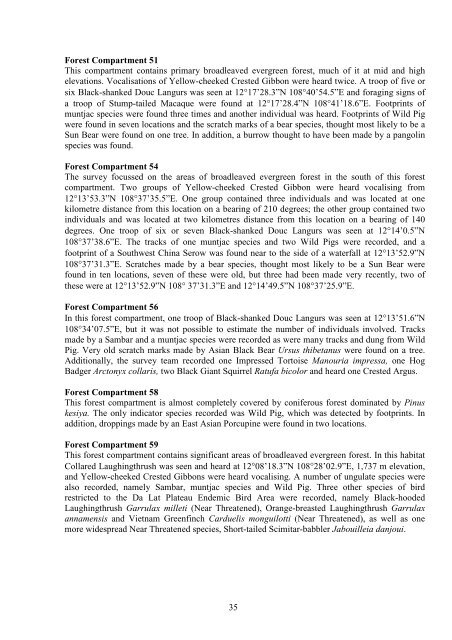a.TFF_rpt_on identification-planning - HCV Resource Network
a.TFF_rpt_on identification-planning - HCV Resource Network
a.TFF_rpt_on identification-planning - HCV Resource Network
You also want an ePaper? Increase the reach of your titles
YUMPU automatically turns print PDFs into web optimized ePapers that Google loves.
Forest Compartment 51<br />
This compartment c<strong>on</strong>tains primary broadleaved evergreen forest, much of it at mid and high<br />
elevati<strong>on</strong>s. Vocalisati<strong>on</strong>s of Yellow-cheeked Crested Gibb<strong>on</strong> were heard twice. A troop of five or<br />
six Black-shanked Douc Langurs was seen at 12°17’28.3”N 108°40’54.5”E and foraging signs of<br />
a troop of Stump-tailed Macaque were found at 12°17’28.4”N 108°41’18.6”E. Footprints of<br />
muntjac species were found three times and another individual was heard. Footprints of Wild Pig<br />
were found in seven locati<strong>on</strong>s and the scratch marks of a bear species, thought most likely to be a<br />
Sun Bear were found <strong>on</strong> <strong>on</strong>e tree. In additi<strong>on</strong>, a burrow thought to have been made by a pangolin<br />
species was found.<br />
Forest Compartment 54<br />
The survey focussed <strong>on</strong> the areas of broadleaved evergreen forest in the south of this forest<br />
compartment. Two groups of Yellow-cheeked Crested Gibb<strong>on</strong> were heard vocalising from<br />
12°13’53.3”N 108°37’35.5”E. One group c<strong>on</strong>tained three individuals and was located at <strong>on</strong>e<br />
kilometre distance from this locati<strong>on</strong> <strong>on</strong> a bearing of 210 degrees; the other group c<strong>on</strong>tained two<br />
individuals and was located at two kilometres distance from this locati<strong>on</strong> <strong>on</strong> a bearing of 140<br />
degrees. One troop of six or seven Black-shanked Douc Langurs was seen at 12°14’0.5”N<br />
108°37’38.6”E. The tracks of <strong>on</strong>e muntjac species and two Wild Pigs were recorded, and a<br />
footprint of a Southwest China Serow was found near to the side of a waterfall at 12°13’52.9”N<br />
108°37’31.3”E. Scratches made by a bear species, thought most likely to be a Sun Bear were<br />
found in ten locati<strong>on</strong>s, seven of these were old, but three had been made very recently, two of<br />
these were at 12°13’52.9”N 108° 37’31.3”E and 12°14’49.5”N 108°37’25.9”E.<br />
Forest Compartment 56<br />
In this forest compartment, <strong>on</strong>e troop of Black-shanked Douc Langurs was seen at 12°13’51.6”N<br />
108°34’07.5”E, but it was not possible to estimate the number of individuals involved. Tracks<br />
made by a Sambar and a muntjac species were recorded as were many tracks and dung from Wild<br />
Pig. Very old scratch marks made by Asian Black Bear Ursus thibetanus were found <strong>on</strong> a tree.<br />
Additi<strong>on</strong>ally, the survey team recorded <strong>on</strong>e Impressed Tortoise Manouria impressa, <strong>on</strong>e Hog<br />
Badger Arct<strong>on</strong>yx collaris, two Black Giant Squirrel Ratufa bicolor and heard <strong>on</strong>e Crested Argus.<br />
Forest Compartment 58<br />
This forest compartment is almost completely covered by c<strong>on</strong>iferous forest dominated by Pinus<br />
kesiya. The <strong>on</strong>ly indicator species recorded was Wild Pig, which was detected by footprints. In<br />
additi<strong>on</strong>, droppings made by an East Asian Porcupine were found in two locati<strong>on</strong>s.<br />
Forest Compartment 59<br />
This forest compartment c<strong>on</strong>tains significant areas of broadleaved evergreen forest. In this habitat<br />
Collared Laughingthrush was seen and heard at 12°08’18.3”N 108°28’02.9”E, 1,737 m elevati<strong>on</strong>,<br />
and Yellow-cheeked Crested Gibb<strong>on</strong>s were heard vocalising. A number of ungulate species were<br />
also recorded, namely Sambar, muntjac species and Wild Pig. Three other species of bird<br />
restricted to the Da Lat Plateau Endemic Bird Area were recorded, namely Black-hooded<br />
Laughingthrush Garrulax milleti (Near Threatened), Orange-breasted Laughingthrush Garrulax<br />
annamensis and Vietnam Greenfinch Carduelis m<strong>on</strong>guilotti (Near Threatened), as well as <strong>on</strong>e<br />
more widespread Near Threatened species, Short-tailed Scimitar-babbler Jabouilleia danjoui.<br />
35
















